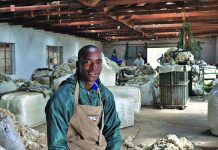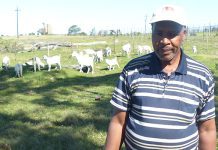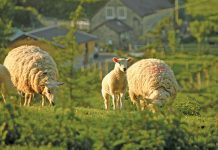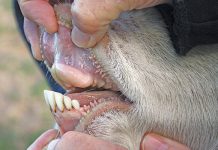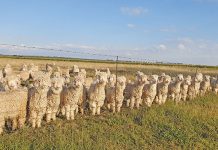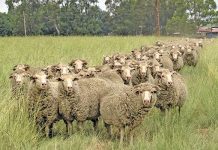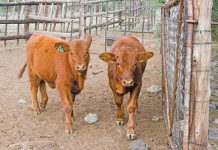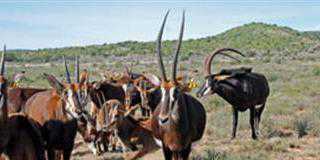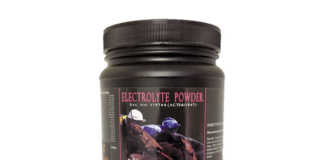Trientjie and Gerhard Knoetze’s Katryn Merino Landsheep Stud in the Wolmaransstad district was started in 2005 with some 50 ewes and now consists of 500.
Gerhard ascribes the stud’s success to hard work, meticulous record keeping, attention to detail and, above all, blessings from the Heavenly Father. “Stud farmers can’t neglect any aspect of their business,” he warns. “You must be precise in all facets and deal with even the smallest matter. Top quality breeding stock is non-negotiable.
“We bought our first 50 Landsheep ewes, which form the basis of our stud, in 2004 from Ockie Nel’s well-known stud near Wolmaransstad. His commercial flock was developed from semen imported from Germany many years ago.”
The enterprise consists of the Merino Landsheep stud, a Bonsmara stud of 300 cows and 700ha planted to maize. The farm has mainly Hutton soils with vlei areas where the sheep graze. Some 250ha is rainfed Smuts finger grass pasture.
Trientjie explains that they decided to branch out into stud breeding as Uitkyk is relatively small, and a stud flock would add more value per hectare than a commercial flock.
“The Landsheep Breeders Society selected the first ewes from this stock. We ran the best stud rams with these ewes, selecting larger-framed rams with a liveweight of 170kg to 180kg which complied with the breed standards.”
Impressed with the landsheep
The Landsheep was developed in Germany in the 13th and 14th centuries from Spanish and French stock, and today constitutes nearly 60% of Germany’s sheep flock. C van der Merwe from Kroonstad imported the first Landsheep into South Africa in 1956.
According to the SA Merino Landsheep Breeders Society website, local farmers were astounded by the breed’s exceptional size. Gerhard and Trientjie are passionate about the Landsheep’s qualities.
“The breed isn’t finicky and eats nearly any type of vegetation,” Gerhard says. “A Roman nose is a prominent Landsheep feature, and helps prevent respiratory problems in Germany’s cold climate.”
Trientjie stresses, “It’s an exceptional dual purpose and highly economical breed, with a large body and Merino-like wool. Although we tend to favour meat production, the flock still produced 1,4t of 25 micron wool in September.
“The Landsheep has a relatively long frame with very little fat. It thrives under both extensive and intensive conditions and can be marketed directly from the veld without any fuss. The breed is also perfectly suited for cross-breeding. An adult ewe weighs 80kg to 100kg and can easily continue lambing until about seven years old.”
Breeding the best
Fertility is non-negotiable in the Katryn stud flock. “The rams run on the veld with the ewes during the day and the flock is kraaled at night to prevent predation and stock theft,” says Gerhard. “Although a good Landsheep ram can work for five to six years, we only use a ram for three years to ensure a high lambing rate. We don’t put rams with their daughters.
“Young and lighter rams run with the young ewes to prevent injury and lambing problems. We haven’t yet used our own rams because we still have some excellent stud rams we bought initially. We raise around 90 rams a year, usually selling them out of hand, but sold seven of our top rams at the 2010 National Landsheep Sale. If all goes well, we will have our first production sale in 2013.”
There are two breeding seasons on Uitkyk – November/December and June/July. The ewes lamb in indoor lambing pens to protect them from predators and the elements, and enable ewe and lamb to bond. “We maintain a very high lambing rate,” says Gerhard. “Triplets are common and quadruplets aren’t unknown. A Landsheep lamb is relatively small and lambing problems are practically unknown to us.
Keeping the lambing ewes in the pens ensures the lamb suckles strongly. We keep them penned for a week and then put them in with the rest of the ewes. These ewes receive a maize-based ration with creep feed – mainly Lubern’s creep feeding pellets – for the lambs. The lambs remain with the ewes until weaning at 90 days and about 30kg. The ewes go back to the veld and the weaned lambs receive Lubern’s full ration pellets until they weigh 50kg to 55kg.”
Management and selection
This is also when the first selection for potential stud animals takes place, and selected young ewes are put on veld with the ewe flock. Selected young rams are put with the adult rams on veld with a Molatek lick. Young rams that lag behind are culled and marketed locally. The final selection by Landsheep Breeders Society inspectors is at 12 months. The ewes then culled are sold as commercial breeding ewes.
“Our ideal Landsheep ewe has pronounced female characteristics with exceptional depth and muscling,” Gerhard explains. “We cull animals with a cylindrical body cross-section, and pay particular attention to grazing capability, ruthlessly culling all sheep with so-called “visbek” jaws, which compromise grazing.”
Although diseases and parasites are seldom a problem, the stud follows a strict animal health programme. The animals are inoculated once a year after shearing against diseases such as pulpy kidney, Rift Valley fever and blue tongue.
Parasites are managed throughout the year as needed. Ticks can be a problem during the rainy season, so sheep are foot-dipped daily. “The high rainfall last year was a problem,” says Gerhard.
“Ticks increased dramatically and the animals suffered from footrot. The wet conditions also affected our lambing percentage, so we had markedly fewer multiple births than usual.”
Future worries
“The future of sheep farming concerns me,” says Gerhard. “Predation and stock theft make it almost impossible to keep farming profitably. Although skyrocketing mutton and lamb prices may be good for producers now, it’s possible consumers will shift to alternative protein sources.”
Contact Trientjie and Gerhard Knoetze on 083 431 4452.

